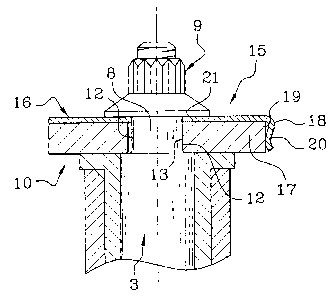Some of the information on this Web page has been provided by external sources. The Government of Canada is not responsible for the accuracy, reliability or currency of the information supplied by external sources. Users wishing to rely upon this information should consult directly with the source of the information. Content provided by external sources is not subject to official languages, privacy and accessibility requirements.
Any discrepancies in the text and image of the Claims and Abstract are due to differing posting times. Text of the Claims and Abstract are posted:
| (12) Patent: | (11) CA 2418356 |
|---|---|
| (54) English Title: | STATOR BLADE PIVOTING ARRANGEMENT IN A TURBOMACHINE |
| (54) French Title: | AUBE PIVOTANTE DE STATOR DE TURBOMACHINE |
| Status: | Term Expired - Post Grant Beyond Limit |
| (51) International Patent Classification (IPC): |
|
|---|---|
| (72) Inventors : |
|
| (73) Owners : |
|
| (71) Applicants : |
|
| (74) Agent: | LAVERY, DE BILLY, LLP |
| (74) Associate agent: | |
| (45) Issued: | 2009-12-15 |
| (22) Filed Date: | 2003-02-04 |
| (41) Open to Public Inspection: | 2003-08-07 |
| Examination requested: | 2008-01-07 |
| Availability of licence: | N/A |
| Dedicated to the Public: | N/A |
| (25) Language of filing: | English |
| Patent Cooperation Treaty (PCT): | No |
|---|
| (30) Application Priority Data: | ||||||
|---|---|---|---|---|---|---|
|
A spring (15) of angular shape is placed between the lug (17) of a connecting rod (10) controlling the orientation of a stator blade and the pivot (3) of said blade, such that its edge (18) bends against one edge face (19) of the connecting rod (10) and the washer (16) moves the pivot (3) in the play of the bore (21) of the connecting rod and sets and maintains the contact between two plane faces (12 and 13), so as to reduce the differences in angular displacements between the connecting rod and pivot due to the play remaining in the bore (21).
Un ressort (15) de forme angulaire est placé entre la patte (17) d'une bielle d'accouplement (10) qui commande l'orientation d'une aube de stator et du tourillon (3) de ladite lame, de telle sorte que son bord (18) se plie contre une face latérale (19) de la bielle d'accouplement (10) et que la rondelle (16) fait déplacer le tourillon (3) dans le jeu de l'alésage (21) de la bielle d'accouplement et établit et maintient le contact entre deux faces planes (12 et 13), de manière à réduire les différences dans les déplacements angulaires entre la bielle d'accouplement et le tourillon à cause du jeu restant dans l'alésage (21).
Note: Claims are shown in the official language in which they were submitted.
Note: Descriptions are shown in the official language in which they were submitted.

2024-08-01:As part of the Next Generation Patents (NGP) transition, the Canadian Patents Database (CPD) now contains a more detailed Event History, which replicates the Event Log of our new back-office solution.
Please note that "Inactive:" events refers to events no longer in use in our new back-office solution.
For a clearer understanding of the status of the application/patent presented on this page, the site Disclaimer , as well as the definitions for Patent , Event History , Maintenance Fee and Payment History should be consulted.
| Description | Date |
|---|---|
| Inactive: Expired (new Act pat) | 2023-02-06 |
| Common Representative Appointed | 2019-10-30 |
| Common Representative Appointed | 2019-10-30 |
| Appointment of Agent Request | 2018-09-14 |
| Revocation of Agent Request | 2018-09-14 |
| Inactive: Agents merged | 2018-09-01 |
| Inactive: Agents merged | 2018-08-30 |
| Grant by Issuance | 2009-12-15 |
| Inactive: Cover page published | 2009-12-14 |
| Inactive: Final fee received | 2009-10-01 |
| Pre-grant | 2009-10-01 |
| Notice of Allowance is Issued | 2009-04-07 |
| Letter Sent | 2009-04-07 |
| Notice of Allowance is Issued | 2009-04-07 |
| Inactive: Approved for allowance (AFA) | 2009-04-01 |
| Letter Sent | 2008-03-17 |
| Letter Sent | 2008-02-22 |
| Letter Sent | 2008-02-22 |
| Letter Sent | 2008-02-22 |
| Letter Sent | 2008-02-22 |
| Letter Sent | 2008-02-22 |
| Letter Sent | 2008-02-22 |
| Letter Sent | 2008-02-22 |
| Request for Examination Received | 2008-01-07 |
| Request for Examination Requirements Determined Compliant | 2008-01-07 |
| All Requirements for Examination Determined Compliant | 2008-01-07 |
| Inactive: IPC from MCD | 2006-03-12 |
| Application Published (Open to Public Inspection) | 2003-08-07 |
| Inactive: Cover page published | 2003-08-06 |
| Inactive: First IPC assigned | 2003-03-31 |
| Inactive: Filing certificate - No RFE (English) | 2003-03-06 |
| Filing Requirements Determined Compliant | 2003-03-06 |
| Letter Sent | 2003-03-06 |
| Application Received - Regular National | 2003-03-06 |
There is no abandonment history.
The last payment was received on 2009-01-28
Note : If the full payment has not been received on or before the date indicated, a further fee may be required which may be one of the following
Please refer to the CIPO Patent Fees web page to see all current fee amounts.
Note: Records showing the ownership history in alphabetical order.
| Current Owners on Record |
|---|
| SNECMA |
| Past Owners on Record |
|---|
| ALAIN CHATEL |
| DOMINIQUE RAULIN |
| FABRICE MAROIS |